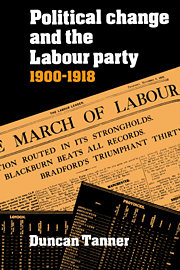Summary
The political changes of 1900–18 have been analysed in a number of different ways. Some historians have emphasised events at the centre, some events in the constituencies. There are studies of national Liberal and of Labour organisation, leadership, policy, and ideology. Local studies of the position in municipal politics abound. Conflicting theories have developed because historians tend to stress the strengths of the party examined, and also because studies of different aspects of the question lead naturally to different conclusions. Moreover, major differences about the nature of politics and political change lurk beneath these discussions, disposing historians to look at questions in very different ways. There has been no single study which embraces all the layers of the debate. Research has progressed simultaneously on disparate lines, with conflicts over some points and interpretations serving only to cloud the real issues. The field is littered with books, articles, and theses, none of which provide a comprehensive explanation of the electoral and political changes.
This attempt to provide a more complete explanation of these changes is dominated by three considerations. First, the debate has taken place in a vacuum. Historians have not grounded their explanations in a full assessment of the electoral position of the respective parties in a sufficiently large number of areas and constituencies; instead they have extrapolated from limited information. Neither have they focused on the ideas and forces which created Labour's electoral strategy.
- Type
- Chapter
- Information
- Political Change and the Labour Party 1900–1918 , pp. xi - xivPublisher: Cambridge University PressPrint publication year: 1990

